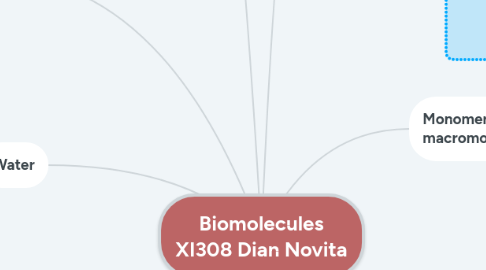
1. The building blocks of life are simple biological molecules which join together to form larger more complex molecule.
2. Carbohydrates
2.1. Monosaccharides
2.1.1. Molecular and structural formulae The molecular formula for a hexose can be written as C6H12O6, Glucose is hexose.
2.1.2. Ring structures One important aspect of the structures of pentoses and hexoses is that the chain of carbon atoms is long enough to close up on itself to form a more stable ring structure.
2.1.3. Functions of monosaccharides in living organism Monosaccharides commonly used as a source of energy in respiration and important as building blocks for large molecules.
2.2. Dissaccharides and the glycosidic bond
2.2.1. Disaccharides, like monosaccharides, are sugars. They are formed by two monosaccharides joining together.
2.2.2. Glycosidic bond an oxygen "bridge" to form between two molecules, holding them together and forming a disaccharides.
2.3. Polysaccharides are polymers made by joining many monosaccharides molecules by condesation.
2.3.1. Starch and glycogen Starch is a mixture of two subtances - amylose and amylopectin. Glycogen is a polysaccharide made of many glucose molecules link together.
2.3.2. Cellulose is a polysaccharides made from betaglucose subunits, used as strengthening material in plant cell walls.
2.4. Dipoles and hydrogen bonds
2.4.1. When atoms in molecules are held together by covalent bonds, they share electrons with each other. Each shared pair of electrons forms one covalent bond.
2.4.2. Hydrogen bonds is a relatively week bond formed by the attraction between a group with a small positive charge on a hydrogen atom.
3. Lipids
3.1. Fatty acids are a series of acids, some of which are found in lipids, contain the acidic group -COOH, known as a carboxyl group.
3.2. Alcohols are a series of organic molecules which contain a hydroxyl group, -OH, attached a carbon atom.
3.3. Triglycerides is a type of lipid formed when three acid molecules combine with glycerol, an alcohol with three hydroxyl (-OH) groups
3.4. Phospholipids are a special type of lipid, each molecule has the unusual property of having one end which is soluable in water
4. Water
4.1. Water as a solvent
4.2. High specific heat capacity
4.3. High latent heat of vaporisation
5. Biochemistry
5.1. Biochemistry looks at the chemical reaction of biological molecules. The sum total of all the biochemical reactions in the body is known as metabolism.
6. Monomers, polymers and macromolecules
6.1. Monomer : a relatively simple molecule which used as basic building block for the synthesis of a polymer.
6.2. Polymer : a giant molecule made from many similar repeating subnits joined together in a chain.
6.3. A macromulecule is a giant molecule. There are three types of macromolecule in living organisms: - polysaccharides - proteins (polypeptides) - nucleic acids (polynucleotids)
7. Proteins
7.1. Amino acids have a central carbon atom which is bonded to an amino group, -NH2 and a caboxylic acid group, -COOH.
7.2. The peptide bond is the covalent bond joining neighbouring amino acids together in proteins.
7.3. Primary structure is the sequence of amino acids in a polypeptide or protein.
7.4. Secondary structure is the structure of a protein molecule resulting from the regular coiling or folding of the chain of amino acids.
7.5. Tertiary structure is the compact structure of a protein molecule resulting from the three dimensional coiling of the chain of amino acids.
7.6. Quartenary structure is the three-dimensional arrangement of two or more polypeptides.
7.7. Globular and fibrous proteins
7.7.1. Haemoglobin - a globular protein Haemoglobin is the red pigment found in red blood cells. Globular protein is a protein whose molecules are folded into a relatively spherical shape,
7.7.2. Collagen - a fibrous protein Collagen is the main structural protein of animals. Fibrous protein is a protein whose molecules have a relatively long.
